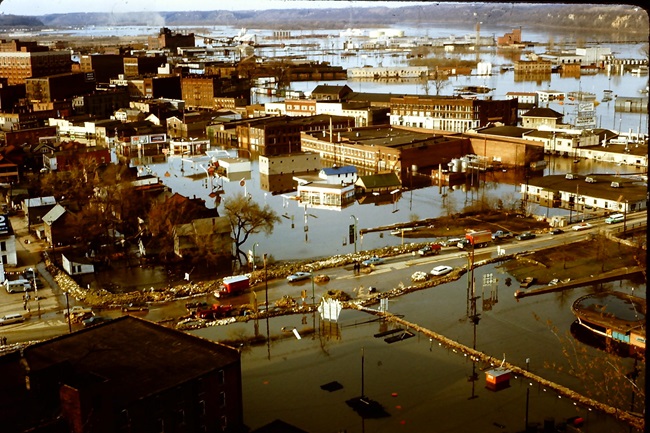April showers bring May flowers, but they also contribute to river flooding. As a Mississippi River town, Dubuque has experienced its share of flooding over the years. Back-to-back floods in 1951 and 1952 each caused some $5 million in damage to the city’s homes and businesses. Although the damage was significant, Dubuquers weren’t overly impressed by the power of the river, and in 1953, voters rejected a $2 million bond issue for a small floodwall.

In March and April of 1965, snowmelt, heavy rains, and a deep frost came together in a perfect storm. Water rushed into the Mississippi forcing the river out of its banks in massive flooding. Nothing in history prepared the City of Dubuque for the record flood crest of 26.81 feet on April 26, 1965.The raging river measured more than nine feet over flood stage and sent three million gallons of muddy river water per second into the city, destroying businesses, homes, and everything in its path. More than 3,000 volunteers, including high school boys released from their studies, flocked to the banks of the river to fill an estimated 400,000 sandbags to be used to build temporary dikes in an effort to keep the approach to the Julien Dubuque Bridge and Locust Street open.
But the rampaging river was too much for some areas. Water soon covered Petrakis Park and surrounded Trausch Baking Co., Dubuque Star Brewery, Sears, Frommelts, and other businesses near the Mississippi. Floodwater stood more than seven feet deep on some city streets. The National Guard came to the rescue and sent trucks and boats to ferry store owners and employees to and from work.
Damage caused by the flood of 1965 topped more than $10 million (over $97 million today) and shut down rail transportation for several weeks. City officials knew something had to be done even before the flood waters began to recede. They began to aggressively renew efforts to get federal funding for a flood-control system.

In 1966, representatives from the Dubuque Packing Co., Trausch Baking Co., Star Brewery, and the Dubuque Chamber of Commerce, along with city administrators and engineers travelled to Washington, D.C., bringing along beer, ham, and bread to present to members of Congress. The gifts were reminders of Dubuque businesses than had been inundated or threatened by the 1965 flood and emphasized the importance of flood protection to the local economy of the city. Their efforts along with those of Iowa U.S. Rep. John Culver helped pave the way to receiving the federal aid needed to get the flood control system off the ground.
The city’s citizens also supported the efforts in obligating the city for $1 million to help with the projected price tag of $12 million for a floodwall with a completion date set for 1973. The estimated cost of the floodwall came in at $10,861,000, with Dubuque and other sources providing $1,330,000. By Memorial Day 1968, the city had the necessary funding in place and was ready to celebrate.
On June 16, 1968, local, state, and federal officials, and a crowd of more than 500 Dubuquers gathered beside the Mississippi River at Hawthorne St. for the floodwall groundbreaking ceremony. Citizens cheered as Dubuque Mayor Sylvester McCauley, U.S. Rep. John Culver, U.S. Sen. Jack Miller, and Brig. Gen. Robert M. Tarbox, commander of the North Central Division of the Army Corps of Engineers, dug into the ground with gold-painted shovels to the tune of “Old Man River” enthusiastically played by the Dubuque Community Band. To enhance the work of the shovel-wielders, an end loader and bulldozer donated by John Deere Dubuque Tractor Works joined in the effort.
Construction of the 29,670-foot-long flood control system that extended from Lock and Dam No. 11 to an area where Moore’s Mill once stood south of the City near Maus Park took five years. On August 4, 1973, city officials dedicated the John C. Culver Floodwall, naming the entire flood-control system of gates, levees, and clay and sand walls after the man whose dedication pushed the infrastructure effort forward and who helped Dubuque officials secure federal funding for the project. In 1998 on the 25th anniversary of the completion of the floodwall, signage designating the Culver Floodwall was erected along the Mississippi Riverwalk, ahalf mile walkway built atop the flood wall in the Port of Dubuque. Today, the Riverwalk is one of the city’s most popular walkways with benches, a gazebo, year-round displays of Art on the River, and views of the Railroad Bridge and the Julien Dubuque Bridge.

Dubuque’s floodwall has been successful in protecting the city from the overfull Mississippi on several occasions since 1973. The combination of thirty-foot concrete walls, seventeen floodgates, four permanent pumping stations, and temporary pumps that can be deployed in an emergency are keeping the city safe. Maintenance of the floodwall system is essential and both city staff and officials from the U.S. Army Corps of Engineers routinely inspect the flood wall. Based on those examinations, the Federal Emergency Management Agency (FEMA) has certified the system is capable of withstanding the flooding Mississippi to a river stage above thirty feet.
As the Mississippi continues to flood and breach the defenses of other cities and towns along the river, Dubuque businesses and residents alike can point to the historic efforts that went into building a flood control system that has protected the city for more than fifty years.
Click to subscribe for convenient delivery of Julien’s Journal by mail, or call (563) 557-7571. Single issues are available in print at area newsstands and digitally on JuliensJournal.com.


Comment here